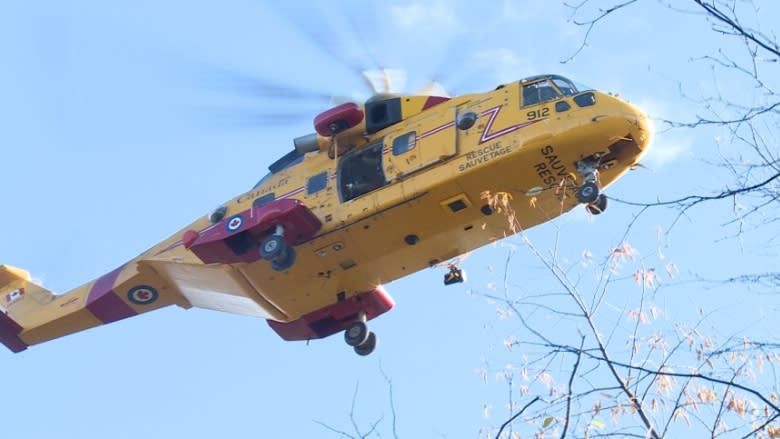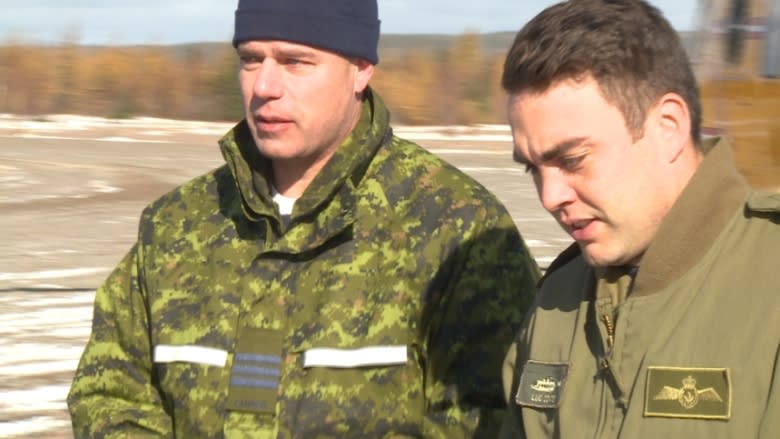Mock disaster puts 9 Wing Gander to the test
Imagine that a foreign military fighter jet flying above Newfoundland crashes in a remote area, and that 9 Wing Gander's new wing commander doesn't know if they can respond.
The idea is not so far-fetched.
"When I arrived here in Gander this summer, I asked about force protection. What do we have in place?" asked Lt.-Col. Pierre Haché.
"Essentially we had nothing that would stand the test of scrutiny."
9 Wing Gander is a Royal Canadian Air Force base in Gander, falling under the jurisdiction of Joint Task Force Atlantic (JTFA), based out of Halifax.
"If JTFA were to ask us to provide initial response to any situation that may arise here in Newfoundland, I did not know what we would be able to provide," said Haché.
"Essentially my answer would have been 'While hold on, I'll have to go figure it out."
Haché spent his first months at the base searching for a way to test 9 Wing Gander.
That's when Exercise Vigilant Bear was born.
In the mock disaster, a German Air Force Tornado - a fighter jet - crash lands near Bucahans. After provincial emergency response teams asses the situation, the military is called in.
JTFA tasks 9 Wing to respond, and the search and rescue mission starts.
Most involved can't recall an exercise like this taking place in Central Newfoundland in years.
'A big hunking burning airplane'
Capt. Carl Squires stands in front about 35 men and women dressed in military camouflage, all sitting inside of a tent blasted by wind.
Squires is the Wing Operations Commander at 9 Wing Gander. For this exercise he's the OPI, running the operation.
"If an aircraft thunders in like this, it could be near a populated area. What do you think people are going to do when they see a big hunking burning airplane?" asked Capt.Squires.
"They're going to want to figure out what it is."
9 Wing has invited government agencies in the region to participate. The RCMP are on hand, Central Health is prepared to respond and fisheries and wildlife officers will help search a nearby lake.
The night before the exercise Capt. Squires suggests that 103 SAR Squadron may be available to assist with their Cormorant helicopter if they aren't tasked on a mission.
Local connection
A busted-out skeleton of a small plane is being used in place of a real German Fighter Jet. Capt. Squires asks the troops to use their imagination.
The night before the exercise is set in motion Capt. Squires pulls aside four members of the Canadian Ranger Patrol Group.
The Buchans Patrol, made up of teachers, welders, chefs, carpenters, "a mix and match of everything," says Sergeant Frank Quirk.
"We're hear to assist the military wherever we can," says Master Cpl. Mike Hurley. "We're acting as the local guide this weekend. Show them around the area."
Hurley said it's exciting time for their group to train with the military, giving them a chance to act out their roles in an emergency situation.
They've gone out searching for missing hunters, lost snowmobilers and overdue hikers — but nothing on this scale.
Capt. Squires calls them an essential asset in an operation like this because of their local knowledge.
Finding the plane
The day of the exercise troops wake up to 2 inches of snow covering the abandoned airfield where they've set up tens.
Most of them have been here for days setting up a dinning tent, command post, kitchen tent and sleeping quarters.
Now in near freezing conditions they're off to search for the downed airplane.
About two hours into the search one of the teams comes across the downed fighter jet. The group of four makes quick work of the scene. They radio in the scene where a deceased pilot (a hospital dummy) is found.
The search starts for the navigator.
Capt. Squires has a surprise: 103 SAR Squadron will be tasked out for the rescue.
'This is pretty realistic'
All eyes are glued to the Cormorant as it takes off from base camp.
"This is pretty realistic," said helicopter pilot Luc Coates during the search for the missing navigator. "I try and keep stats but they're all over the place. Last year we averaged - we had 103 missions in a year, so that's pretty much one every three days."
"Normally on a blue sky day like this, we get few of them. It's normally on night, low visibility and low clouds."
Once a member of the Cormorant helicopter spots the team that's found the missing navigator, the helicopter door swings open. Crew members are hooked onto the helicopter as they lean out of the open door, shouting out distance estimates and signaling nearby trees.
The helicopter lands without issue and two Search and Rescue techs are greeted by a member of the search party who's driven to the landing spot — a small strip of sandy beach off the lake — to update the crew.
After a short walk to the navigator, played by a member of 9 Wing Gander, and a thorough medical check, a flare is set off and the helicopter hovers above to hoist both the SAR tech and patient to the helicopter.
The cormorant is met by an ambulance waiting at the abandoned airfield where base camp is set up and Central Health takes over.
Mission success
"We rose to the occasion," said Lt.-Col. Haché.
"I'm very confident that if the need arose - if the requirement arose - we would be able to respond. Just because of what we did this week we would be able to respond in a very positive and productive manor to the demands of the provincial government or JTFA."
The commander isn't alone in his faith of 9 Wing Gander's ability to respond.
"The community is very happy to see these fellows here. They're a great bunch of guys," said Buchans Mayor Derm Corbett.
"We're confident that if us or any other small town on the island has to call upon these guys in times of emergency — we've got the best that there is with these fellows here."



